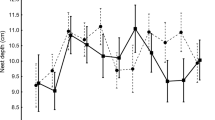Abstract
Birds move between breeding locations to gain a better territory, avoid competition or reduce the deleterious effect of inbreeding. We investigated breeding site fidelity in a small European passerine, the penduline tit (Remiz pendulinus). This species has an exceptionally diverse breeding system, in which both males and females may have up to 5–7 mates in a single breeding season, and the eggs are incubated by a single parent: either the male or the female. We investigated the movements of males and females within three breeding seasons in Southern Hungary (2002–2004). Males moved for shorter distances between breeding sites (116 m, 63–333 m; median, lower quartile–upper quartile) than females (942 m, 415–2,382 m). Movements of males and females were consistent between years, and they were repeatable between subsequent nests of males, but not of females. Taken together, our results suggest that adult male penduline tits are more site-faithful than adult females. We suggest that this difference has an implication on their breeding ecology since male parental behaviour (desert/care) is expected to be influenced by local mating opportunities, whilst female parental behaviour is likely to depend on the mating opportunities in a large area around their breeding site.



Similar content being viewed by others
References
Bleeker M, Kingma SA, Szentirami I, Székely T, Komdeur J (2005) Body condition and parental behaviour in penduline tits. Behaviour (in press)
Clobert J, Danchin E, Dhondt AA, Nichols JD (2001) Dispersal. Oxford University Press, Oxford
Cramp S, Simmons KEL (1983) Handbook of the birds of Europe, the Middle East and North Africa—birds of the Western Palearctic. Oxford University Press, Oxford, pp 376–396
Franz D, Theiss N (1983) Brutbiologie und Bestandsentwicklung einer farbberingten Population der Beutelmeise Remiz pendulinus. Verh Ornithol Ges Bayern 23:393–442
Gilpin ME (1991) The genetic effective size of a metapopulation. Biol J Linn Soc 42:165–175
Greenwood PJ, Harvey PH (1982) The natal and breeding dispersal of birds. Ann Rev Ecolog Syst 13:1–21
Harper DGC (1994) Some comments on the repeatability of measurements. Ringing Migr 15:84–90
Hatchwell BJ, Russell AF, Ross DJ, Fowlie MK (2000) Divorce in cooperatively breeding long-tailed tits: a consequence of inbreeding avoidance? Proc R Soc Lond 267:813–819
Klemp S (2003) Altitudinal dispersal within the breeding season in the grey wagtail Motacilla cinerea. Ibis 145:509–511
Könczey R, Tóth L, Török J (1997) Site fidelity of great and blue tits in the Pilis-Visegrád mountains. Opusc Zool Budapest 29–30:103–111
McNamara JM, Székely T, Webb JN, Houston AI (2000) A dynamic game-theoretic model of parental care. J Theor Biol 205:605–623
Persson O, Öhrström P (1989) A new avian mating system: ambisexual polygamy in the penduline tit Remiz pendulinus. Ornis Scandinavica 20:105–111
Pilastro A, Biddau L, Marin G, Mingozzi T (2001) Female brood desertion increases with number of available mates in the rock sparrow. J Avian Biol 32:68–72
R Development Core Team (2004) R: a language and environment for statistical computing. R Foundation for Statistical Computing, Vienna (ISBN: 3-900051-07-0)
Székely T, Webb JN, Cuthill IC (2000) Mating patterns, sexual selection and parental care: an integrative approach. In: Apollonio M, Festa-Bianchet M, Mainardi D (eds) Vertebrate mating systems. World Science, London, pp 194–223
Weatherhead PJ, Boak KA (1986) Site fidelity in song sparrows. Anim Behav 34:1299–1310
Welling L, Thomson L (2003) MySQL tutorial. MySQL,Uppsala (ISBN: 0-672-32584-5)
Wheelwright NT, Mauck RA (1998) Philopatry, natal dispersal and inbreeding avoidance in an island of population of savannah sparrow. Ecology 79:755–767
Winkel W, Frantzen M (1991) Population-dynamics of the blue tit (Parus caeruleus)—long-term investigations in the Braunschweig region. J Ornithol 132:81–96
Acknowledgements
This paper is dedicated to Professor Christian Pitra on the occasion of his 65th birthday, 29 April 2006. The project was funded by the Hungarian Science Foundation (OTKA T031706, T043390), The Royal Society (15056) and by grants from the Dutch ‘Groningen Universiteits Fonds’ and the Dutch ‘Marco Polo Fonds’. T. Székely was also supported by BBSRC (BBS/B/05788). Permissions were provided by the Kiskunság National Park and Szegedfish Kft. We acknowledge the assistance of M. Bleeker, K. Hayes, P. Horváth, S.A. Kingma, O. Menyhárt and T. Szabó in collecting data in the field. We also want to thank Prof. J. Szabad for his comments on an early draft. The study was licensed by the Kiskunsági National Park, Hungary (577-3/2002, 390-2/2003, 1097-5/2004).
Author information
Authors and Affiliations
Corresponding author
Rights and permissions
About this article
Cite this article
Mészáros, A.L., Kajdocsi, S., Szentirmai, I. et al. Breeding site fidelity in penduline tit Remiz pendulinus in Southern Hungary. Eur J Wildl Res 52, 39–42 (2006). https://doi.org/10.1007/s10344-005-0001-7
Received:
Accepted:
Published:
Issue Date:
DOI: https://doi.org/10.1007/s10344-005-0001-7




